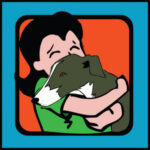Canine bloat, also known as gastric dilation, is the number one killer of several breeds of large dogs. Canine bloat is a painful disorder that sees the dog’s stomach fill with gases that are unable to escape. Studies have shown that such large dog breeds as Great Danes, wolfhounds, Akitas, German Shepherds, greyhounds, bloodhounds, boxers, and Irish Setters are all at high risk for an episode of canine bloat. The condition is extremely dangerous, as thirty percent of the dogs that develop canine bloat die from it in a short time or have to be euthanized.
One quarter of canine bloat victims experience gastric dilation, where the stomach fills with gas and this increased pressure then compresses both ends of the stomach, allowing nothing in or out. Three quarters of the time, a condition called gastric volvulus occurs, where the stomach of the dog “flips” on itself. The stomach twists, cutting off any escape of gases, fluids, or food from either end. The trapped gases cannot get out, and they then expand, causing the excessive bloating associated with this condition which can be quickly fatal if the stomach ruptures. The twisted stomach can also obstruct veins in the abdominal region, resulting in low blood pressure, damage to organs, and shock. In addition, the stomach can have its own blood flow cut off and experience tissue death from lack of oxygen.
It takes very little time for a case of canine bloat to turn fatal, meaning you do not have a long time frame in which to react to this emergency, only an hour or two. One of the most comprehensive studies ever done on canine bloat identified various factors as being responsible for it. Dogs with deep and narrow chest cavities are most at risk, due to the fact that there is more room in their body for the stomach to move. Lean dogs had more problems with bloat than overweight ones, with the thinking behind this being that the lean dog has more room in its abdomen for the stomach to bloat and twist; the fat in an overweight canine takes up more space in this region, making it harder for the stomach to flip.
Older dogs are more at risk as well, with the chance of this happening going up twenty percent each year after the age of five in large breeds. Canine bloat also runs in families, with a two out of three chance of it happening to a dog that has had it occur in their mother, father, brother, or sister. Dogs that eat very fast are in peril of this fate, as are nervous, stressed, and aggressive dogs. Dogs that eat and drink from raised food and water dishes suffer from the condition by more than one hundred and ten percent than those who eat from normal dishes. Eating only dry dog food, and eating one large meal daily, also contributes to the chance of canine bloat taking place in a dog. The dogs that bloated in this study were found to have a stretched ligament that maintains the stomach’s normal position in the abdomen. This stretching was attributed to the dog eating the one big meal a day. The study also found no evidence to support theories that exercise and water consumption before and after meals had anything to do with canine bloat.
The symptoms of canine bloat are many, but one of the most obvious will be if the abdomen is distended and tight, although it does not always appear this way. Dogs afflicted with bloating and twisted stomachs will try to vomit unsuccessfully in an attempt to relieve the pressure, not act normal, be restless, and appear to be hunched up. They cannot swallow so they will drool, and they may attempt to defecate with nothing coming out.
Almost half of dogs in this condition will have some sort of heart arrhythmia, which can cause death. The rupturing of the stomach wall and the shock from a flipped stomach can also kill them, so time is of the essence in dealing with canine bloat. Once the dog has been taken to the veterinarian, an attempt will be made to decompress the stomach with a tube passed down the throat and into the stomach. If the tube is blocked by the twisting, then a hypodermic needle will be employed through the side of the abdomen to relieve the excess pressure. If the dog’s stomach remains twisted after the gas has been removed, it will require surgery to put it back into its normal position.
If this can be done successfully, the vet will often perform an operation called a gastropexy, where the stomach wall is attached to the abdomen wall so it cannot flip again in the future. Three quarters of the dogs that have a twisted stomach and don’t have this procedure will have it occur again, many within a few months of the original incident. In the breeds that are most in danger of having a canine bloating event, preventive surgery is often performed when they are neutered to avoid this potentially fatal condition from happening.



